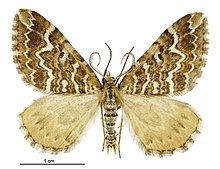| Asaphodes clarata | |
|---|---|
 | |
| Female | |
 | |
| Male | |
| Scientific classification | |
| Domain: | Eukaryota |
| Kingdom: | Animalia |
| Phylum: | Arthropoda |
| Class: | Insecta |
| Order: | Lepidoptera |
| Family: | Geometridae |
| Genus: | Asaphodes |
| Species: | A. clarata |
| Binomial name | |
| Asaphodes clarata (Walker, 1862) | |
| Synonyms [1] | |
| |
Asaphodes clarata, also known as the large striped carpet moth, is a species of moth of the family Geometridae. This species is endemic to New Zealand and has been found on the North and South Islands. The species inhabits open grassy areas, including tussock grasslands, in montane habitat. The larvae feed on the leaves of Ranunculus species. The adult moths are day flying and are on the wing from December to February and have been shown to pollinate Celmisia laricifolia and Hebe pinguifolia.


